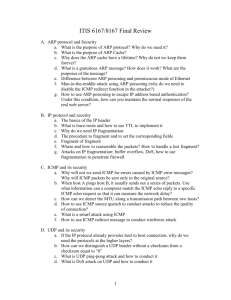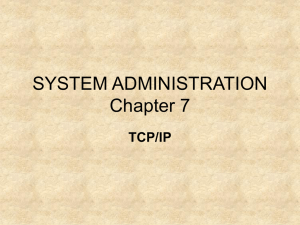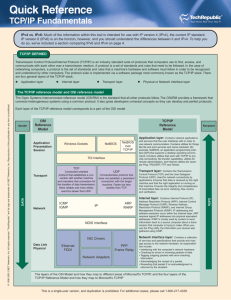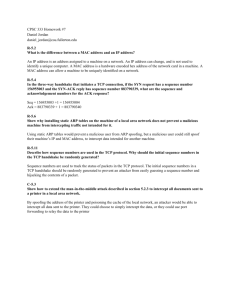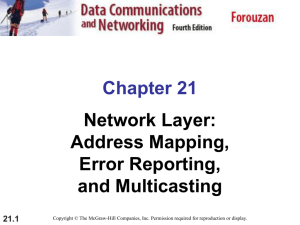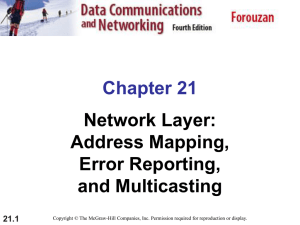Document
advertisement
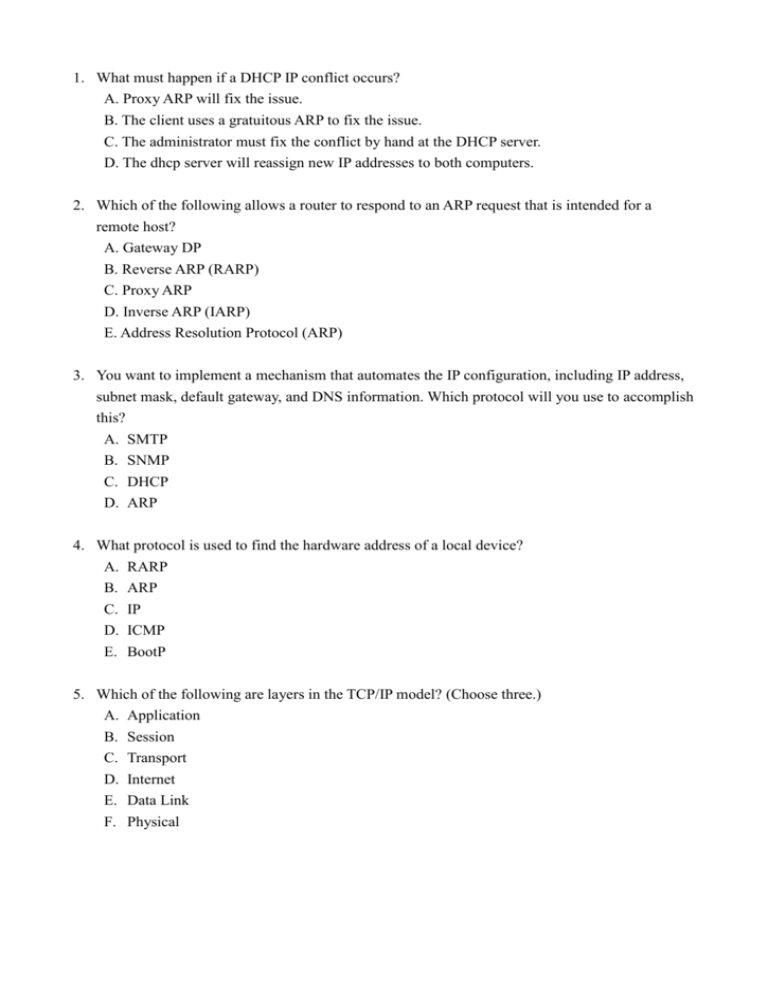
1. What must happen if a DHCP IP conflict occurs? A. Proxy ARP will fix the issue. B. The client uses a gratuitous ARP to fix the issue. C. The administrator must fix the conflict by hand at the DHCP server. D. The dhcp server will reassign new IP addresses to both computers. 2. Which of the following allows a router to respond to an ARP request that is intended for a remote host? A. Gateway DP B. Reverse ARP (RARP) C. Proxy ARP D. Inverse ARP (IARP) E. Address Resolution Protocol (ARP) 3. You want to implement a mechanism that automates the IP configuration, including IP address, subnet mask, default gateway, and DNS information. Which protocol will you use to accomplish this? A. SMTP B. SNMP C. DHCP D. ARP 4. What protocol is used to find the hardware address of a local device? A. RARP B. ARP C. IP D. ICMP E. BootP 5. Which of the following are layers in the TCP/IP model? (Choose three.) A. Application B. C. D. E. F. Session Transport Internet Data Link Physical 6. Which class of IP address provides a maximum of only 254 host addresses per network ID? A. Class A B. C. D. E. Class B Class C Class D Class E 7. Which of the following describe the DHCP Discover message? (Choose two.) A. It uses FF:FF:FF:FF:FF:FF as a layer-2 broadcast. B. It uses UDP as the Transport layer protocol. C. It uses TCP as the Transport layer protocol. D. It does not use a layer-2 destination address. 8. Which layer-4 protocol is used for a Telnet connection? A. IP B. TCP C. TCP/IP D. UDP E. ICMP 9. How does a DHCP client ensure that no other computer has its assigned IP address? A. B. C. D. E. Acknowledge receipt of a TCP segment. Ping to its own address to see if a response is detected. Broadcast a Proxy ARP. Broadcast a gratuitous ARP. Telnet to its own IP address. 10. Which of the following services use TCP? (Choose three.) A. DHCP B. SMTP C. SNMP D. FTP E. HTTP F. TFTP 11. Which of the following services use UDP? (Choose three.) A. DHCP B. SMTP C. SNMP D. FTP E. HTTP F. TFTP 12. Which of the following are TCP/IP protocols used at the Application layer of the OSI model? (Choose three.) A. IP B. TCP C. Telnet D. FTP E. TFTP 13. The following illustration shows a data structure header. What protocol is this header from? A. IP B. ICMP C. TCP D. UDP E. ARP F. RARP 14. If you use either Telnet or FTP, what layer are you using to generate the data? A. Application B. Presentation C. Session D. Transport 15. The DoD model (also called the TCP/IP stack) has four layers. Which layer of the DoD model is equivalent to the Network layer of the OSI model? A. Application B. Host-to-Host C. Internet D. Network Access 16. Which two of the following are private IP addresses? A. 12.0.0.1 B. 168.172.19.39 C. 172.20.14.36 D. 172.33.194.30 E. 192.168.24.43 17. What layer in the TCP/IP stack is equivalent to the Transport layer of the OSI model? A. Application B. Host-to-Host C. Internet D. Network Access 18. Which statements are true regarding ICMP packets? (Choose two.) A. ICMP guarantees datagram delivery. B. ICMP can provide hosts with information about network problems. C. ICMP is encapsulated within IP datagrams. D. ICMP is encapsulated within UDP datagrams. 19. What is the address range of a Class B network address in binary? A. 01xxxxxx B. 0xxxxxxx C. 10xxxxxx D. 110xxxxx 20. Which of the following protocols uses both TCP and UDP? A. FTP B. SMTP C. Telnet D. DNS


